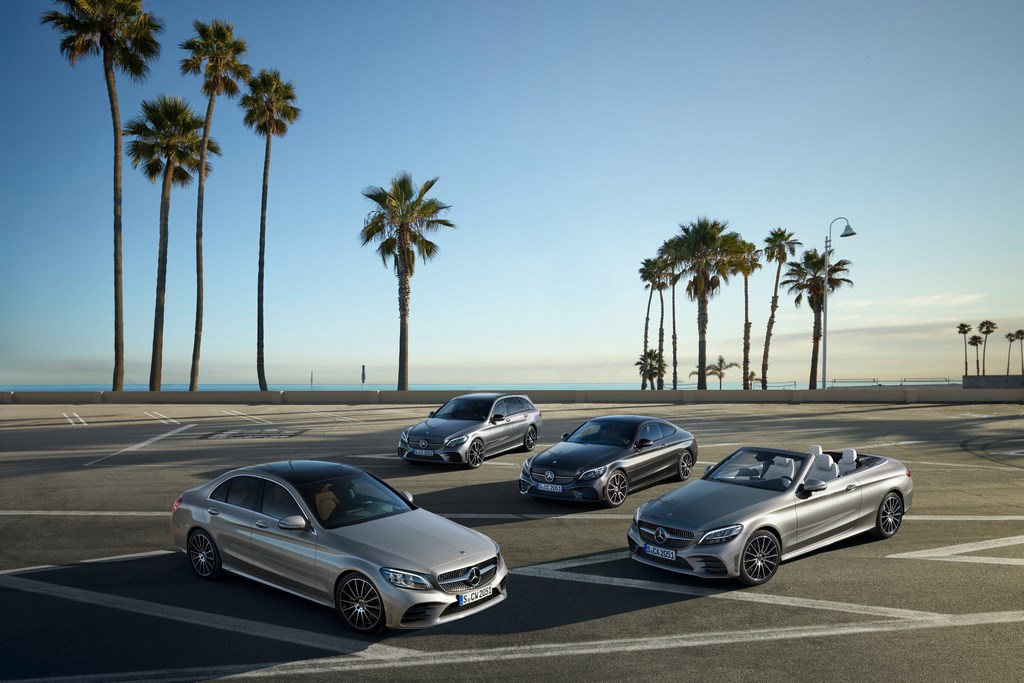Modern classics: the Mercedes-Benz W 201 series (1982 – 1993)
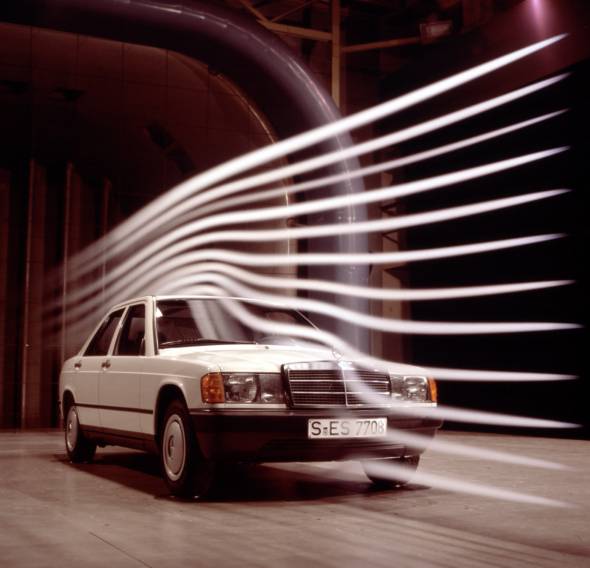
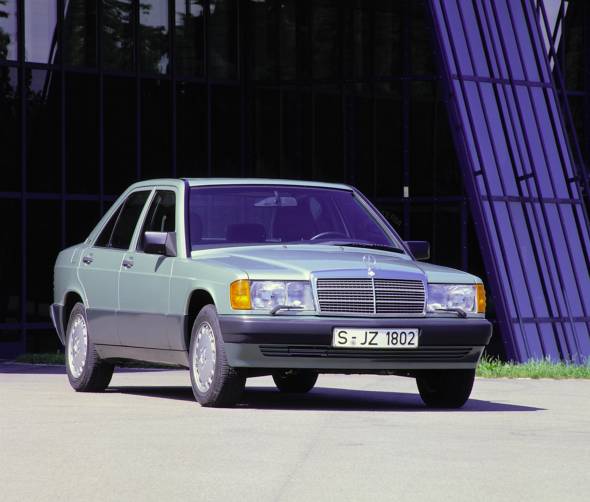
- “Baby Benz” heralds the brand’s model initiative of 1982
- It sets new standards using technically sophisticated solutions in the compact class
- Around 1.9 million vehicles in the W 201 series built over a period of more than ten years.
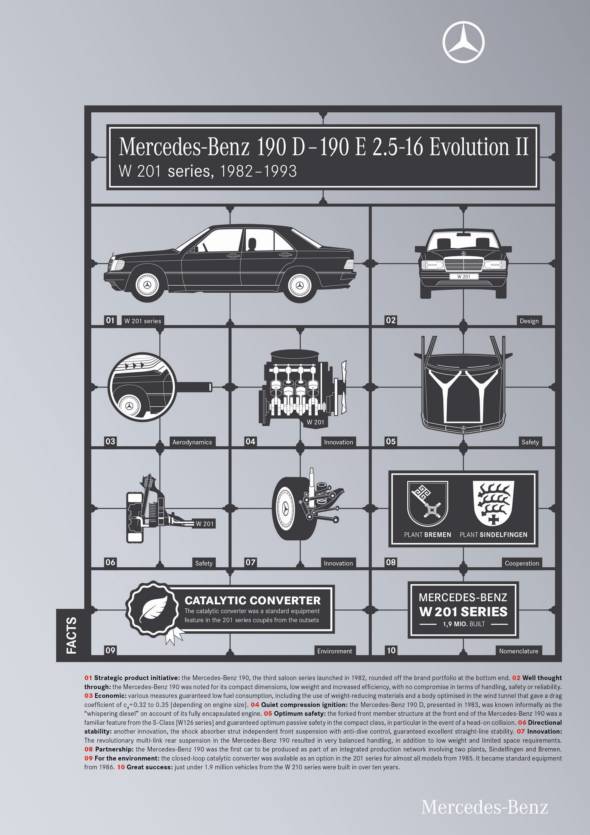
Stuttgart – The presentation of the Mercedes-Benz W 201 series on 8 December 1982 was an event eagerly anticipated by public and trade press alike. The W 201 did not follow a predecessor series, but added a third saloon line to the passenger car range along with the S-Class and E-Class – and caused something of a sensation at the time. Together with the SL-CLass and G-Class, the W 201 was the fifth passenger car series by Mercedes-Benz and as such heralded the launch of the brand’s model initiative. The first models were the 190 and 190 E.
The new model series was noted for its more compact dimensions, reduced weight and increased economy; nevertheless, it did not compromise on aspects such as handling characteristics, safety and reliability. The W 201 series existed exclusively as a saloon during its lifetime, earning it the prefix “W” as an in-house series designation.
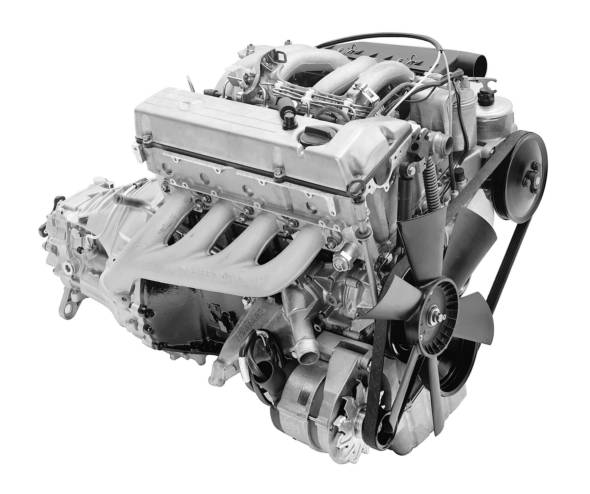
The W 201 series was initially nicknamed “Baby Benz” by customers from North America. Nevertheless, its external bodywork concealed genuine qualities. Pioneering features ensured high standards in terms of passive safety, the drive system and other aspects of automotive technology. In 1982 the brochure for the 190 series promised “Top-class Mercedes technology in compact form.” The series fulfilled its promise, and the C-Class – whose tradition it established – has been doing the same ever since.
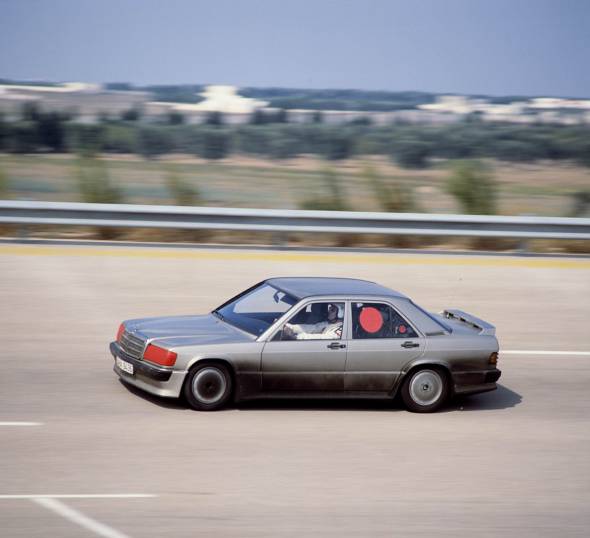
One element of this was the joy of technical innovation. For example, the W 201 series benefited from a chassis with multilink rear suspension, was designed using weight-saving high-strength steel, had an aerodynamically optimised body and featured a high degree of passive safety. It was also extremely economical, since a range of measures – including the use of lightweight materials and an aerodynamic body optimised in the wind tunnel to give a drag coefficient of cd=0.32 to 0.35 (depending on engine size) – guaranteed low fuel consumption.
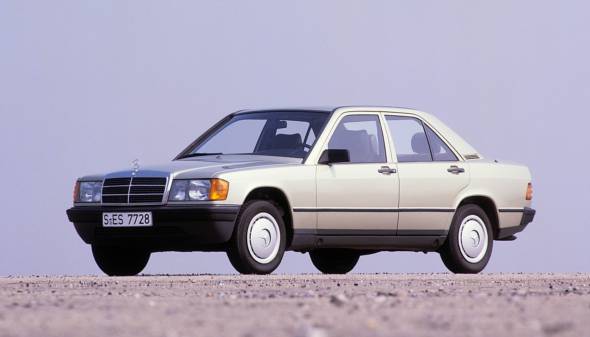
The series also set new standards in terms of engine design – a sealed diesel unit that earned for the 190 D model the name “whispering diesel” and four-valve petrol units that turned the compact class into high-performance athletes.
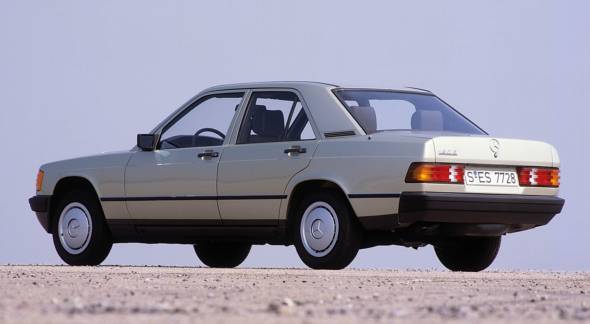
All these aspects also turned the W 201 series into a modern classic. For it wrote automotive history, showing that in design and engineering terms those values previously the preserve of larger vehicles could also be realised using more compact dimensions. It enabled the company to expand its model range and diversify into a hitherto unrepresented vehicle segment. For many customers it was the compact Mercedes-Benz they had been yearning for as a principal car, for others it was the perfect second vehicle to own alongside one of the brand’s larger saloons.
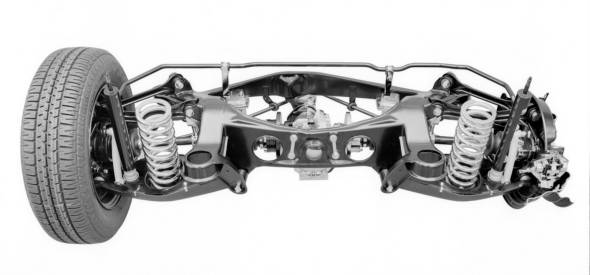
These qualities have enabled the W 201 series to make a statement in the current automotive landscape. Those who drive it as a modern classic – in whichever version – are not only demonstrating a sense of tradition but also keeping one eye on the future. For the key indicators for this compact Mercedes-Benz are as valid today as they have ever been. A further bonus for everyday operation is the comprehensive parts supply via the Mercedes-Benz service organisation – which still guarantees availability for virtually every replacement part. And Mercedes-Benz Young Classics in Stuttgart even has a number of first-class complete vehicles for sale or hire – and all with a manufacturer’s warranty.
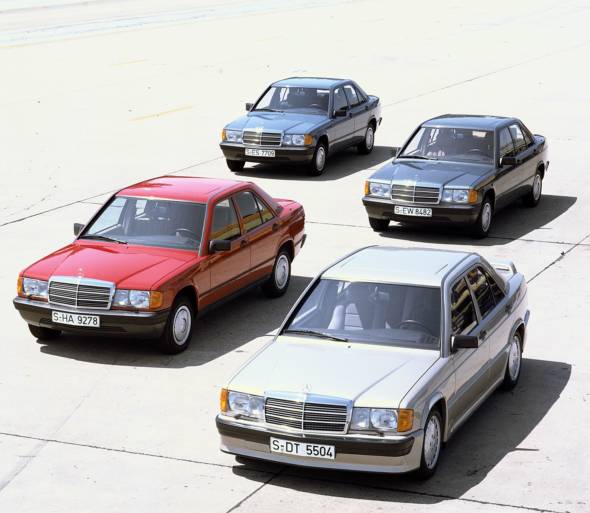
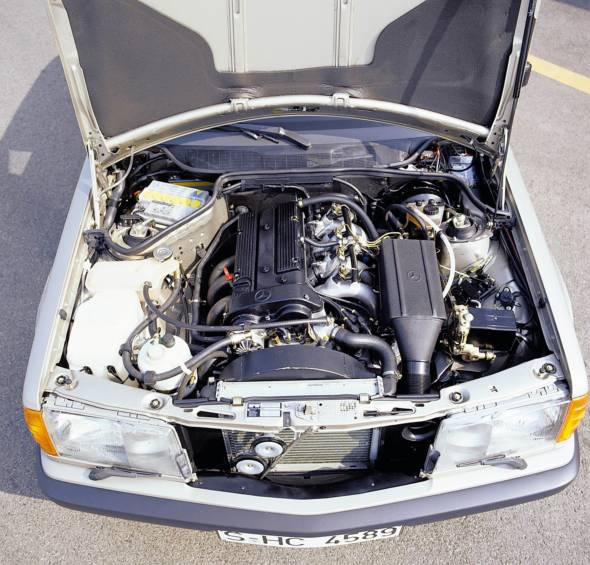
Model history: the Mercedes-Benz W 201 series (1982 – 1993)
- A Mercedes-Benz below the long-established mid-range series
- Brilliant engineering achievement: No compromises in safety, ride comfort and space
- Multi-link independent rear suspension setting new standards in chassis technology
When the 190 was first presented in December 1982, it didn’t look particularly revolutionary. Yet the Mercedes-Benz mid-size sedan, known within the company as the “compact class” and positioned below the E-Class, S-Class and SL-Class, became a milestone for the future development of the Mercedes-Benz model portfolio. Its strong, clear lines matched its product claim as a genuine Mercedes-Benz, an embodiment of progress, about to step out into a new car category.
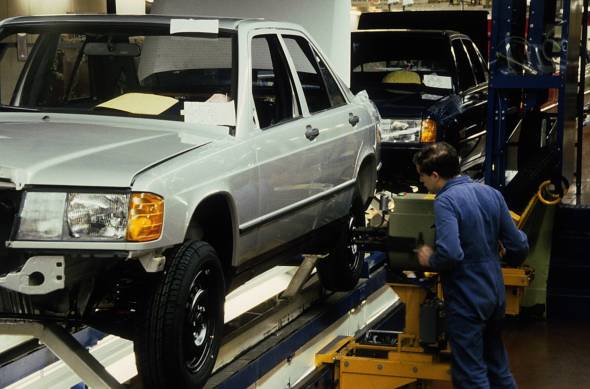
With its clearly defined wedge shape and finely chiseled light-catching contours, there was nothing reticent about the new model series, proudly taking its place in the Mercedes family. The man responsible for the fresh linear design was Bruno Sacco. The first models in the W 201 series were the 190 and 190 E which quickly became a major success and role models. As well as providing the basis for subsequent C-Class generations, the 190 sedan, known affectionately as the Baby Benz, also became the first shot in Mercedes-Benz’s product drive.

The Mercedes-Benz compact class – or C-Class as it became known as from the subsequent W 202 series, according to the nomenclature introduced at the time – clearly aimed to replicate the virtues of its bigger relations in terms of handling, passive safety and reliability. Along with its smaller size, the new Mercedes-Benz was also lighter and very economical.

To reduce fuel consumption, the Mercedes engineers optimized the aerodynamics of the body and also used high-strength sheet steel and other innovative materials to reduce the weight of the car. As a result, the 190 weighed just 1180 kilograms, without any reductions in passive safety. One of the features providing passive safety commensurate with the S-Class sedans was the forked-member structure of the front end. This design, taken from the S-Class from the 126 series, ensured that the 190 also met the requirement for an asymmetrical frontal collision at 55 km/h with 40 percent overlap.
New standards set by the multi-link independent rear suspension
The 190 also had a revolutionary new chassis design, developed specifically for the new model, which proved a great success. The main feature was the multi-link independent rear suspension. Each of the rear wheels was located by five independent links for optimum wheel control, with lateral and longitudinal forces effectively balanced in all driving situations.
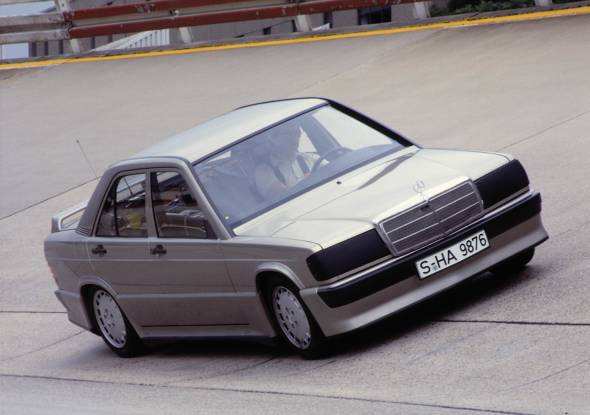
This improved steering precision and ensured very well-behaved handling characteristics. The new rear axle design was also lighter and more compact than its predecessors. The front axle featured shock-absorber struts located by individual triangular wishbones and anti-dive control. This gave the W 201 excellent straight-line stability, and being a relatively flat structure it also left a lot of space under the hood.
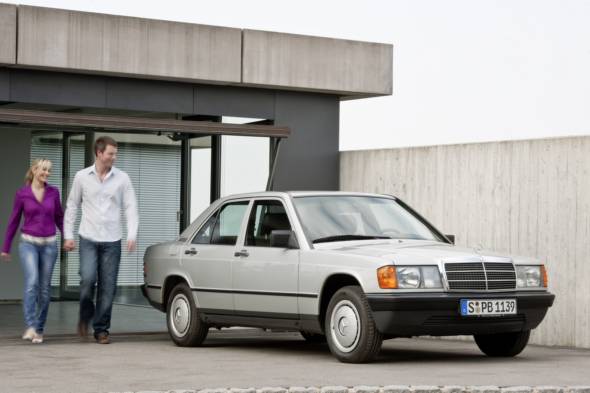
These chassis innovations delivered their benefits only once the car was on the road, but there were some other surprises in store for Mercedes drivers used to the S-Class and mid-series as soon as they entered the car. Instead of having a foot-operated parking brake, as used in all Mercedes passenger models made in Stuttgart from 1968, the W 201 model series had a conventional parking brake, operated by means of a lever between the front seats. The engineers saw this as a way of saving space in the foot well, and in any event, little effort was required for applying the parking brake in the compact class car because of the latter’s lighter weight.
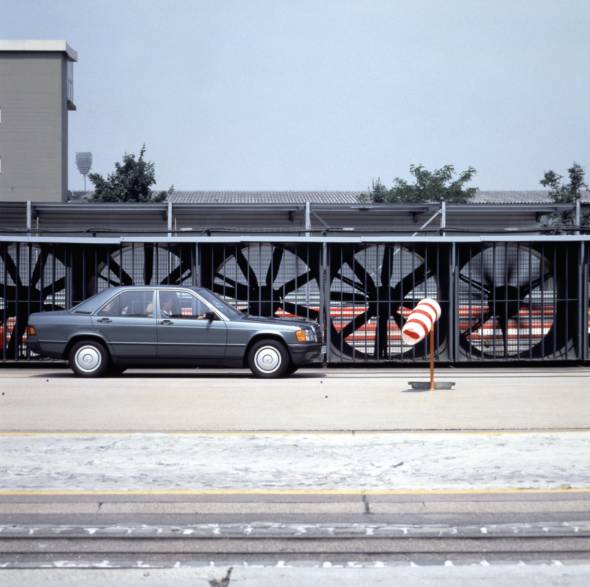
The 190 was built in Sindelfingen and Bremen. Production began in Sindelfingen, with the assembly line in the Bremen factory starting up later, in November 1983. The plant had had to be modernized for production of the Mercedes-Benz compact class in a long and expensive process. The mid-series station wagon (S 123) had been manufactured in Bremen from early 1978.
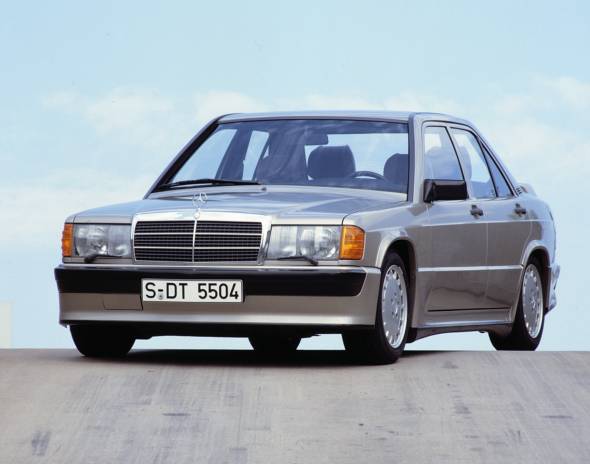
Production of the new compact class was organized as a joint operation between the two locations – the first time in the company’s history that such an arrangement was used to this extent. One of the routine requirements for this cooperation at a distance of several hundred miles was the exchange of body components. For example, Bremen produced the engine hoods, floor assemblies, fuel tanks and doors, while all other sheet metal components came from Sindelfingen. Along with this interchange of components between the two locations, engines, transmissions, and axles were shipped to both plants from Untertürkheim, and the steering gear assemblies were sourced from Düsseldorf.
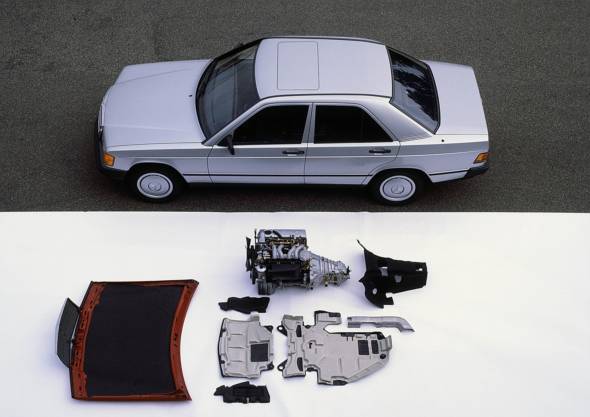
Start of production with the 190 and 190 E
Mercedes-Benz started production of the 190 and 190 E models in 1982; the 190 D and 190 E 2.3-16 followed in 1983 and 1984, respectively. The first two models, both gasoline-powered, were fitted with four-cylinder engines with a displacement of 1997 cubic centimeters, delivering 66 kW and 90 kW, respectively.
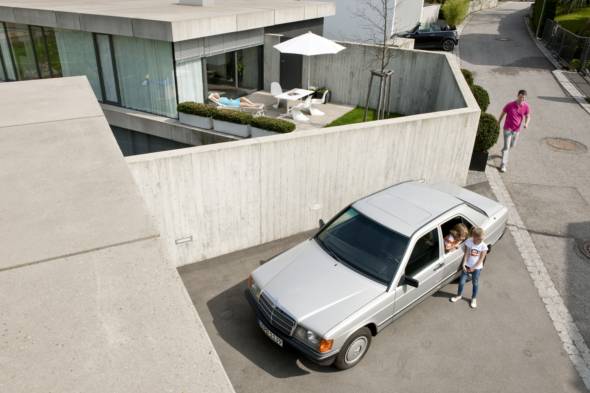
The units from the M 102 family of engines were based on the engine used in the Mercedes-Benz 200 (W 123) introduced in 1980. For the 190, engine power was trimmed back from 80 kW to 66 kW by reducing the size of the intake and exhaust ducts and fitting a modified camshaft and smaller valves. At 90 kW, the engine of the 190 E delivered significantly more power thanks to gasoline injection. This was the first time the Mercedes-Benz engineers used the mechanical electronically-controlled Bosch KE-Jetronic injection system, giving the compact 190 E a top speed of up to 195 km/h, and “Mercedes-style spiritedness,” as the 1982 brochure put it.
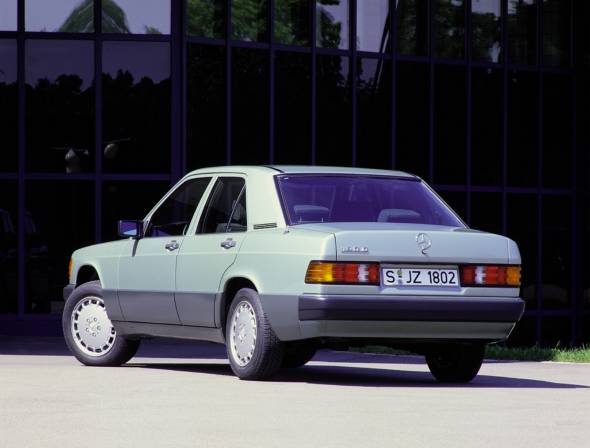
Just one year later, the 190 D came along with a completely newly developed four-cylinder diesel engine with a displacement of 1997 cubic centimetres – a configuration that intrigued people. With its exemplary encapsulation, this engine prepared the ground for state-of-the-art diesel technology in Mercedes-Benz passenger cars. Known as the “whisper diesel,” the engine emitted only half the noise of comparable power plants. The new diesel, which also had a respectable power output of 53 kW and low fuel consumption, proved to be a highly successful innovation and was soon in high demand. A total of 452,806 units of the 190 D were built over the ten years it remained in production.
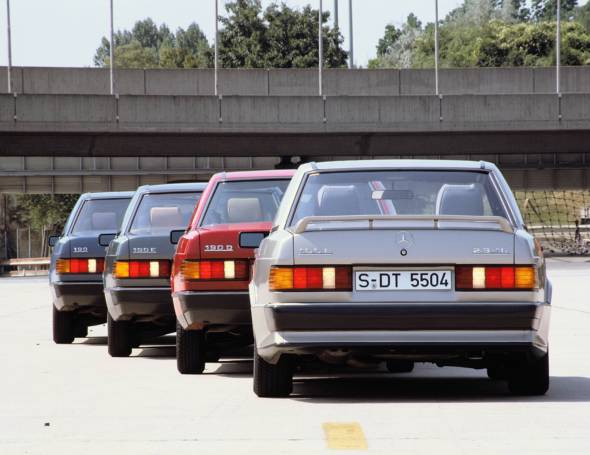
In 1984 the new 190 E 2.3-16 made its debut at the top end of the model series. Even in appearance, the new model was very different, with a clear profile as a compact sports car highlighted by features such as the wing-type spoiler at the rear. For the engine, the company’s engineers went back to the W 123 series. The four-cylinder engine with 2299-cc displacement as used in the 190 E 2.3-16 had a newly designed cylinder head with two intake and two exhaust valves. These and other modifications boosted engine power from 100 kW to 136 kW, with acceleration from standstill to 100 km/h in just 7.5 seconds. The car’s top speed was 230 km/h.
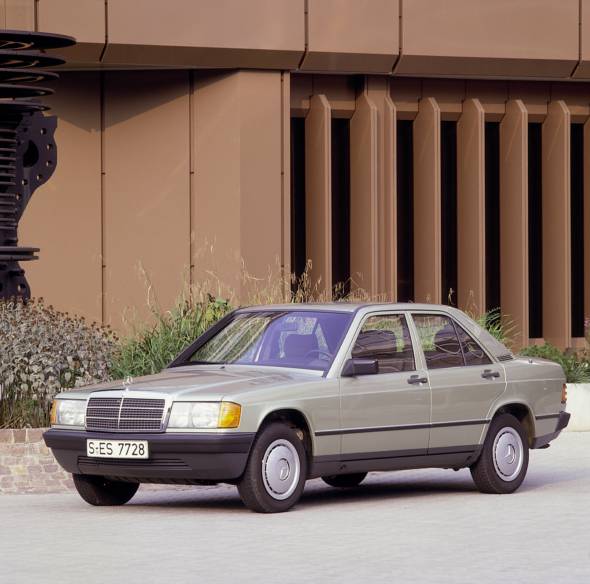
World long-distance records in Nardo
The 190 E 2.3-16 had been able to show what it could do as early as in 1983 the year of its presentation at the Frankfurt International Motor Show. Four weeks before the launch, three prototypes of the model had set several world long-distance records over 25,000 kilometers, 25,000 miles, and 50,000 kilometers, with average speeds of almost 250 km/h, in Nardo, southern Italy. These results were a foretaste of the 190’s subsequent career as a sports car. The new Mercedes-Benz racing car made its debut in the official opening race on the new Nürburgring on May 12, 1984. The road-going version of the 16-valve model went into production in September 1984, in two metallic finishes: blue black and smoke silver.
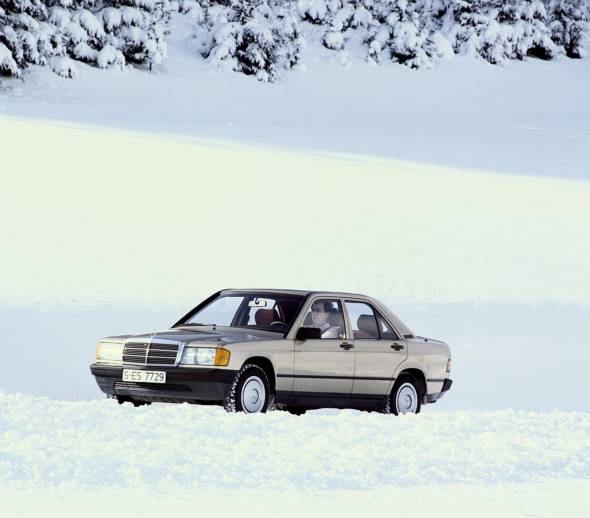
Two more compact class models came in 1983 for export to North America only. These US versions were the diesel-engined 190 D 2.2 and gasoline-engined 190 E 2.3. For the diesel version, the displacement volume was increased to 2197 cubic centimetres by lengthening the stroke. This compensated for the loss in power resulting from the fitting of an exhaust gas recirculation (EGR) system. This feature was essential for a car exported to the US, particularly in view of the stringent emission limits in California. The modified diesel engine delivered 54 kW, practically the same as in the standard version.
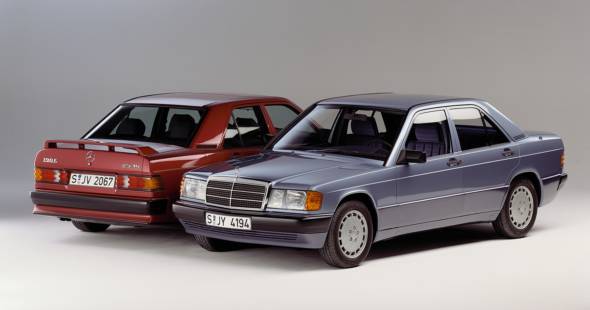
The closed-loop emission control system initially made the gasoline-engined 190 E 2.3 significantly less powerful than the 230 E (W 123). The rating of 83 kW instead of 100 kW put the larger-displacement export version even below the standard 190 E. This problem was solved in 1984 with a modified intake manifold, a redesigned camshaft and a newly tuned injection system. The 190 E 2.3 now delivered 90 kW, on a par with the two-liter model.
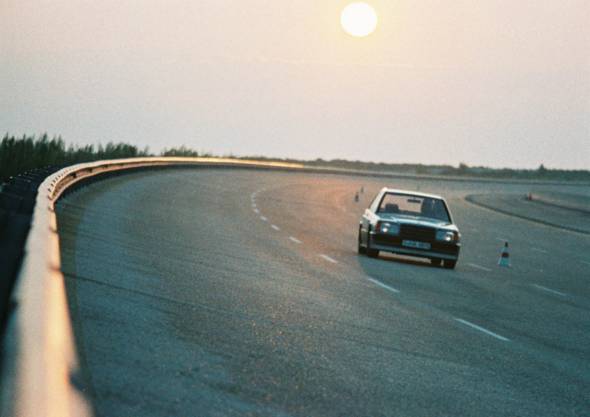
The 190’s engine with carburetor had its performance boosted just two years after being launched into the market. The derated version was replaced with an engine without any performance restrictions, and the Mercedes-Benz design engineers also raised the compression ratio. The basic model of the series, internally known as the 190/1, now delivered 77 kW, an increase of 11 kW. The more effective exhaust silencers were the only thing that prevented the engine from matching the output of its W 123 counterpart.
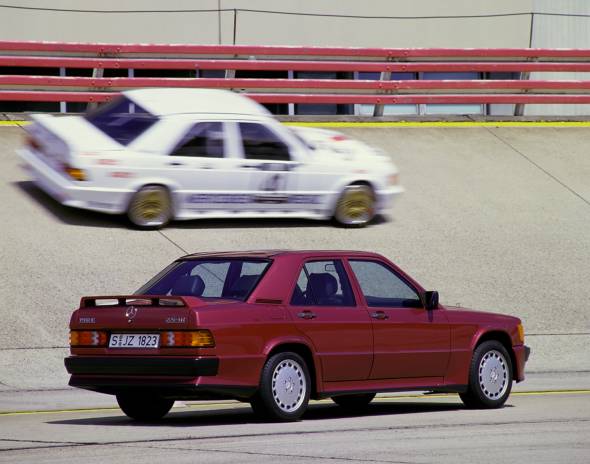
The refinement package for the 190 and 190 E included single-belt drive, hydraulic valve clearance compensation and hydraulic engine bearings. At the time of the market launch of the new mid-sized W 124 series in January 1985, the specifications of the compact class were extended by the addition of new wheels (diameter: 38.10 centimetres), electrically heated windshield wiper nozzles and an eccentric-sweep windshield wiper with a significantly larger swept area. From September 1985, power steering and electrically heated exterior mirrors were fitted as standard on all models.

But as well as introducing technical improvements to the compact class, the arrival of the mid-series W 124 also changed perceptions of the 190. The latter had previously been stylistically completely distinct from the profile of other Mercedes-Benz models, but the introduction of the W 124 with features consistent with the brand profile made it quite clear that the compact model series had become the trendsetter for a new design language of Mercedes-Benz cars.
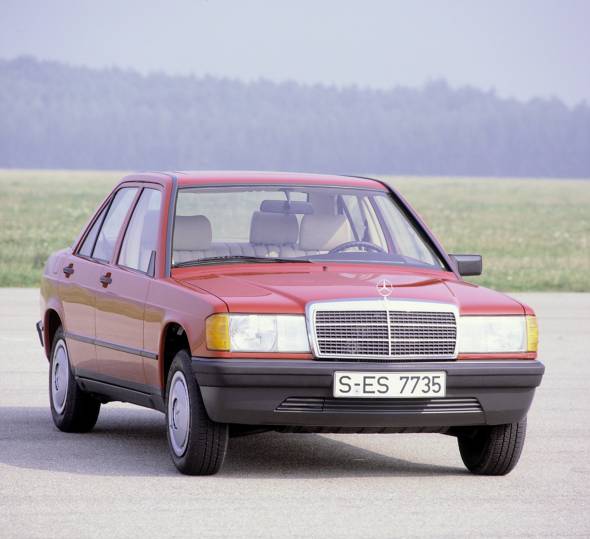
Mercedes-Benz added two new models to the series in 1985, starting with the 190 D 2.5, a sedan powered by the five-cylinder diesel engine from the 250 D, with a displacement of 2497 cubic centimetres and output of 66 kW. As well as providing the same impressive fuel economy as the 190 D, the compact diesel also had impressive performance and a top speed of 174 km/h.

Six-cylinder engines provide new qualities
The follow-up to the five-cylinder diesel engine came in the fall of 1985 when Mercedes-Benz actually installed a six-cylinder in-line engine in the 190. The 190 E 2.6 was displayed at the Frankfurt International Motor Show in September of that year. In combination with a five-speed manual transmission, the 2566-cc engine delivered 122 kW and accelerated the car from standstill to 100 km/h in just 8.2 seconds. The top speed was 215 km/h. Visitors to the motor show were impressed by the design skills employed to fit a large six-cylinder engine into the limited space available under the hood of the 190.
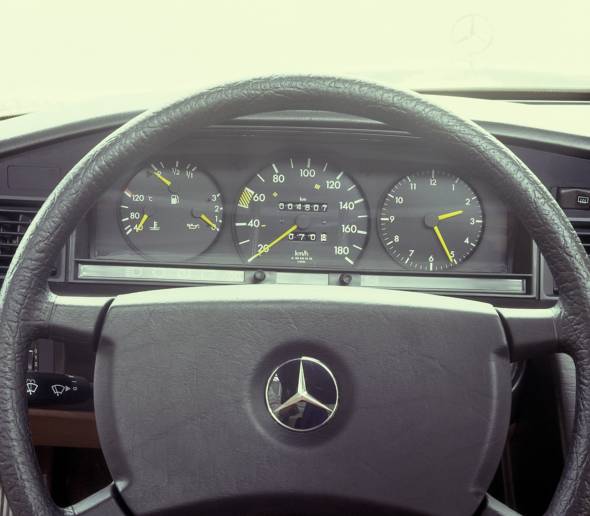
The Mercedes-Benz engineers had come up with a masterpiece of made-to-measure automotive packaging. The external indications of the higher power of the 190 E 2.6 were twin exhaust pipes and the deeper and more steeply angled front apron with wider louvers. Just a few weeks after the 190 E 2.6 had made its debut, the 500,000th 190 rolled off the assembly line. The new model with gasoline injection engine had not yet contributed to this milestone.
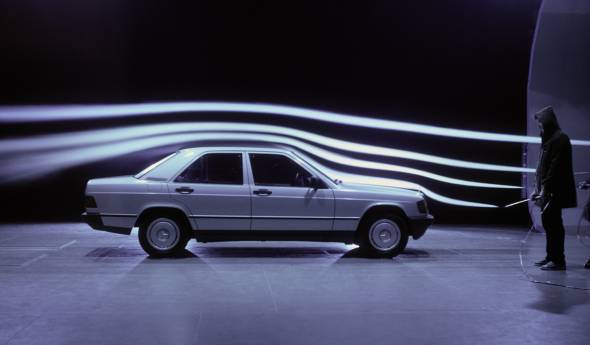
Production of the 190 E 2.6 started in April 1986, and the new model was finally launched into the market in October 1986, together with the 190 E 2.3. The main difference between this variant of the W 201 and the export version of the same name was the four-cylinder engine with normal compression ratio and a power output of 100 kW.
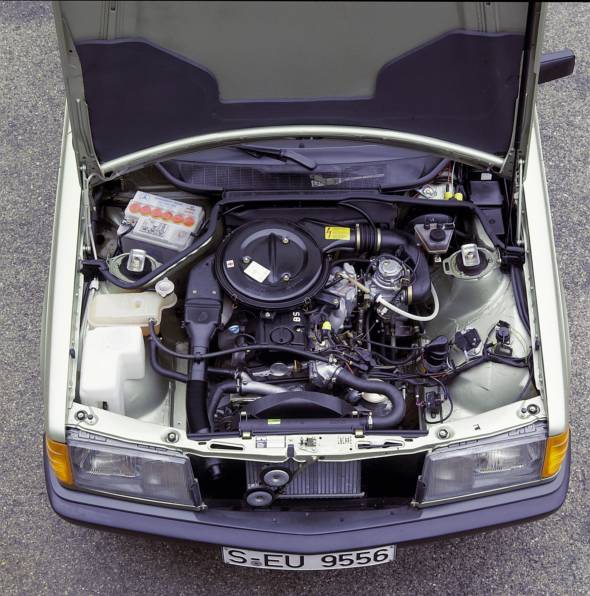
From that time, all gasoline-engined models were available with the option of a closed-loop emission control system with a three-way catalytic converter, except for the 190 with carburetor. As an alternative option, Mercedes-Benz also offered cars which were prepared for retrofitting, with a multi-functional mixture preparation and ignition system, but without catalytic converter or lambda sensor. Older cars could also easily be retrofitted with the closed-loop catalytic converter.
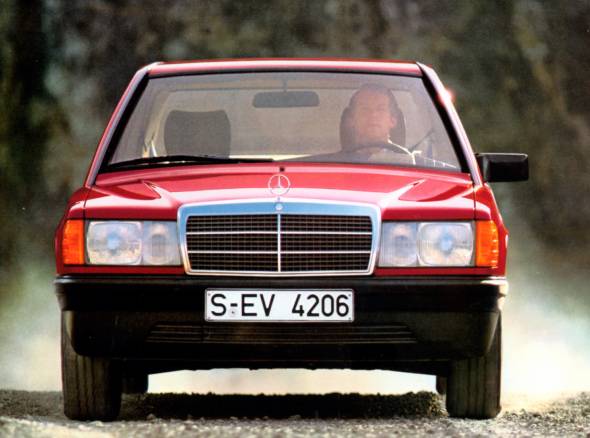
These alternatives gave vehicle owners the flexibility to decide when to switch to a closed-loop emission control system. From September 1986, the carburetor model was also available with an emission control system, and the closed-loop catalytic converter became standard equipment on all gasoline-engined Mercedes-Benz passenger car models. Cars prepared for retrofitting were still available on request until August 1989, at a lower price than the equivalent version with catalytic converter.
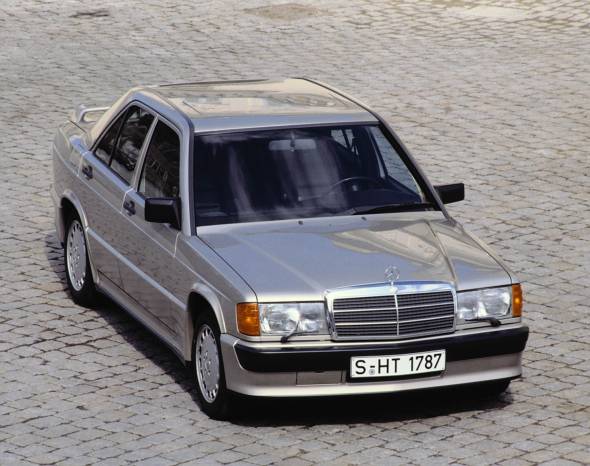
A sprightly diesel makes its debut
In 1987, the compact class continued on its course towards diesel cars with sporty performance. In September of that year, Mercedes-Benz presented the 190 D 2.5 Turbo at the Frankfurt International Motor Show. The engine was a 90-kW five-cylinder turbodiesel compression-ignition unit, derived from the proven naturally aspirated engine.
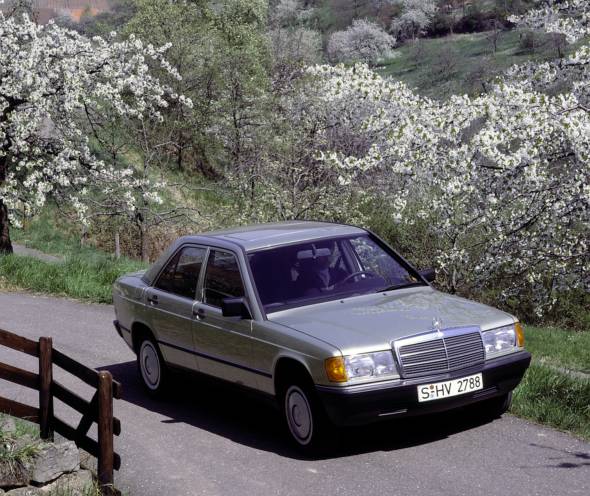
The exhaust-gas turbocharger boosted power by 24 kW, resulting in a top speed of 192 km/h and acceleration from standstill to 100 km/h in 11.5 seconds. The visual trademark of the new model, exported to the USA from as early as fall 1986, was the six louvers in the front right fender, between direction indicator and wheel cut-out. These were not a decorative feature with martial connotations, but were vital in supplying the turbocharger with the amount of air it required. Another difference between the turbodiesel and its sister model with naturally aspirated engine was the twin-pipe rear silencer.
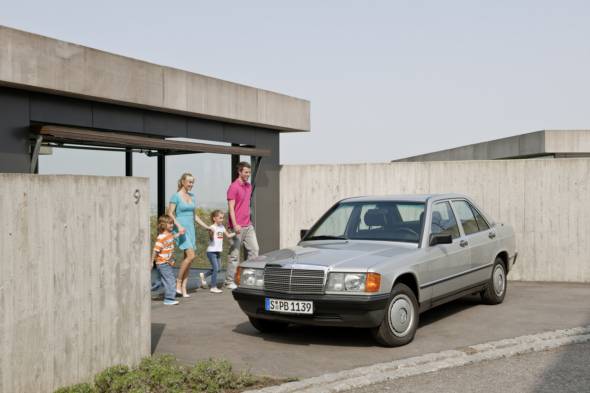
The one-millionth W 201 rolled off the assembly line in Bremen in March 1988. By now, the compact class had established itself as Mercedes-Benz’s third major model series. The company also fundamentally revised the 190 in 1988. The refined compact class was unveiled at the Paris Motor Show in September 1988, six years after the presentation of the first 190. The main focus was on the restyling of the body and the new-look interior. The most striking feature of the refined models was the protective side strips with integrated side skirt paneling, similar to those in the coupes from the 124 model series.
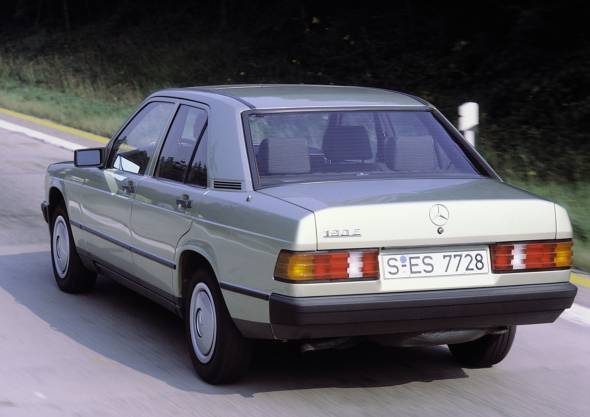
The front and rear spoilers reached further down and were combined with larger bumpers, with new support elements and modified impact absorbers designed for increased energy absorption. The new front apron had been adopted from the 190 E 2.6 and was now used on all models to reduce the lift at the front axle. The purpose of new spoiler at the rear was to optimize the airflow outflow. The refinement package also included the nearside exterior mirror as part of the standard equipment. The new interior design made the 190 more spacious and more comfortable for both driver and occupants, with more knee and head room in the rear and improved seats at both front and rear.
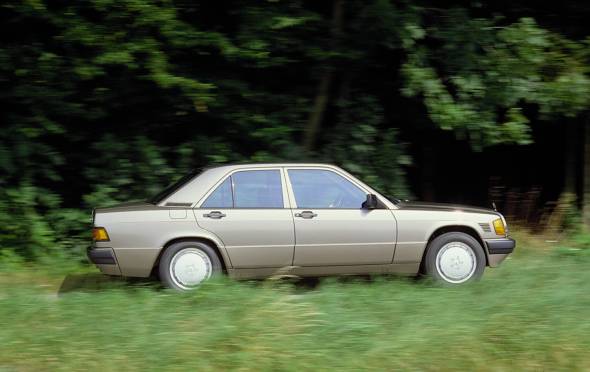
Simultaneously with the refinement, Mercedes-Benz also introduced its new top-of-range model for the compact class: the 190 E 2.5-16, replacing the first 16-valve engine with a 2.3-liter unit after four years. The engine was actually based on its predecessor, benefiting from a longer stroke.
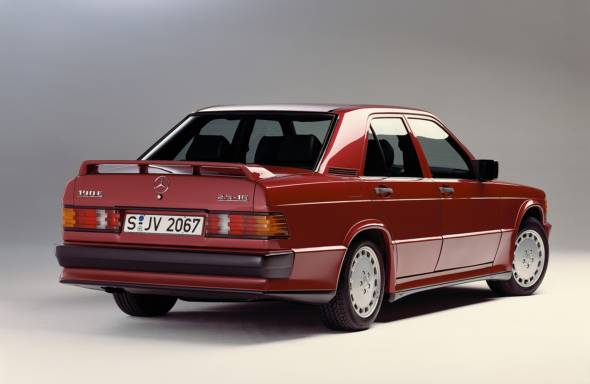
The new engine, with catalytic converter, developed 143 kW – 18 kW more than its predecessor. Even with the catalytic converter, the performance of the new model matched the 190 E 2.3-16 without emission control system. The new 16-valve model was also identified as a descendant of the Nardo record car by its visual appearance. Two new paint finishes were now available, complementing the blue black and smoke silver finishes by the addition of the metallic finishes almandine red and astral silver.
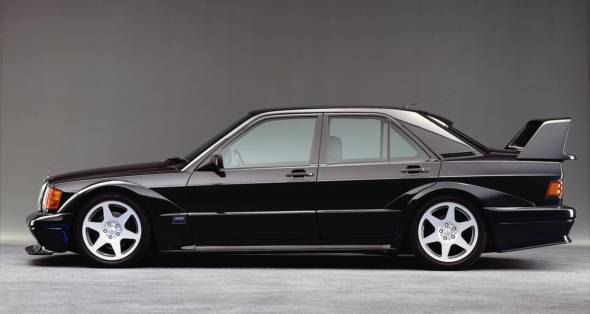
The 190 E 2.5-16 as a racing car
The 190 E 2.5-16 also became the basis for the sports cars entered in Group A of the German Touring Car Championship (DTM). The type-approved base model was the Mercedes-Benz 190 E 2.5-16 Evolution with the M 102 E 25/2 engine, further modified for racing. The next development stage came one year later with the 190 E 2.5-16 Evolution II model. In its production version, this car, again presented for the first time at the Geneva Motor Show, delivered 173 kW, with performance boosted still further.
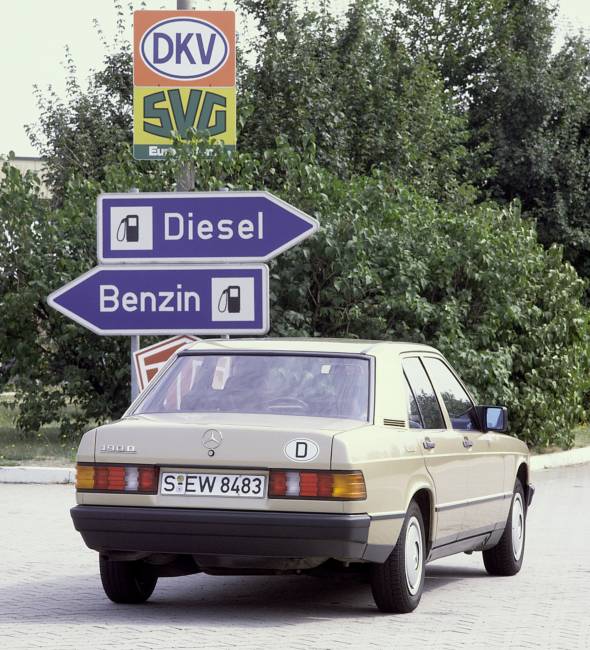
From February 1989, in the context of the “Diesel ‘89” initiative, Mercedes-Benz started fitting all its diesel-engined passenger car models with reworked engines with particulate emissions reduced by 40 percent through optimization of the combustion cycle. The optimized diesel models were virtually smoke-free and met the stringent particulate emissions limits in the U.S.A. even without a particulate trap. This was made possible by newly designed prechamber combustion with oblique fuel injection for more efficient combustion.
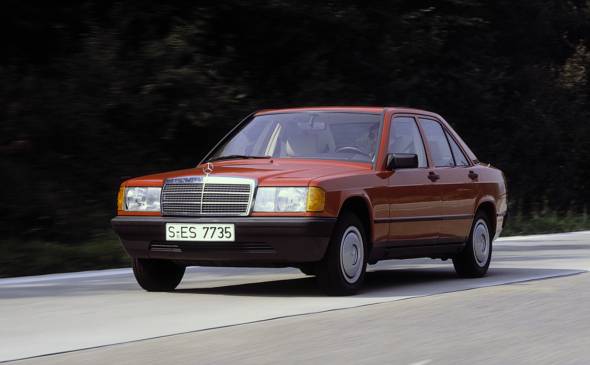
The injection pumps in all naturally aspirated diesel engines now also had an altitude correction unit (vacuum cell) to keep emissions down even when driving at high altitudes. A favorable side effect of the new diesel technology was a power increase of two kW in the 190 D and three kW in the 190 D 2.5. From as early as September 1988, cars with turbocharged diesel engines were fitted with comparable technology – which meant that the output of the 190 D 2.5 Turbo was boosted to 93 kW.
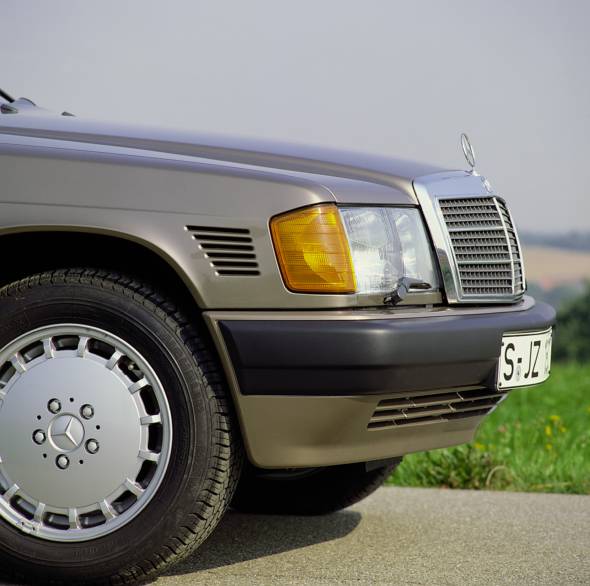
A sophisticated emission control system introduced in 1990 further reduced pollutant emission levels. To achieve this, Mercedes-Benz opted for an oxidation catalyst specially developed for diesel engines and combined with an exhaust gas recirculation system. This highly efficient system was available as optional equipment from October 1990, initially for cars with naturally aspirated diesel engines, then six months later for turbocharged models as well.
The Sportline package, a new equipment variant for the 190, came onto the market in June 1989. The package was available for all models and featured a suspension lowered by 21 mm, tauter springs and shock absorbers, 7J x 15 alloy wheels with wide tires in 205/55 R 15 format, and seating as in the 16-valve model. This did not apply to the 190 E 2.5-16 which already boasted sporty equipment in its standard version.
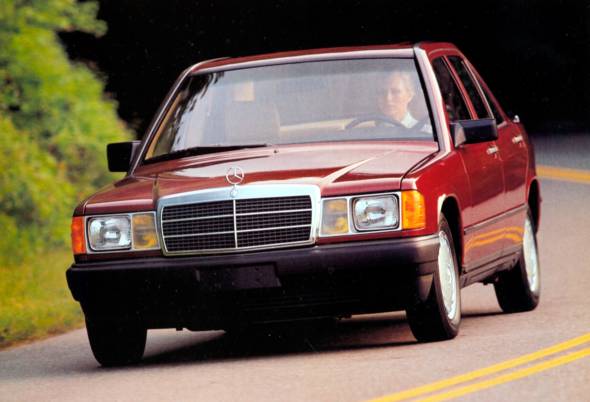
The era of gasoline engines with carburetors at Mercedes-Benz ended in 1990. In the case of the W 201 model series, this meant that the 190 E 1.8 model replaced the 190 that had been in production for over seven years. The new engine had a displacement of 1797 cubic centimeters and delivered 80 kW with catalytic converter. It had been derived from the two-liter engine in the 190 E by reducing the stroke, and used the same mechanically/electronically controlled Bosch KE-Jetronic injection system.
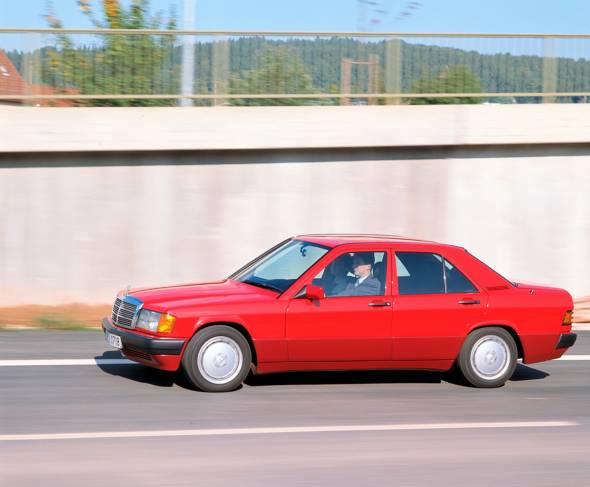
Final refinement
The 190 was refined for the last time in 1991. Among other things, all models now featured the ABS anti-lock braking system, except for the 190 D and 190 E 1.8 entry-level models. The 190 E was now called the 190 E 2.0, and was three kW more powerful, thanks to a lower-resistance exhaust system.
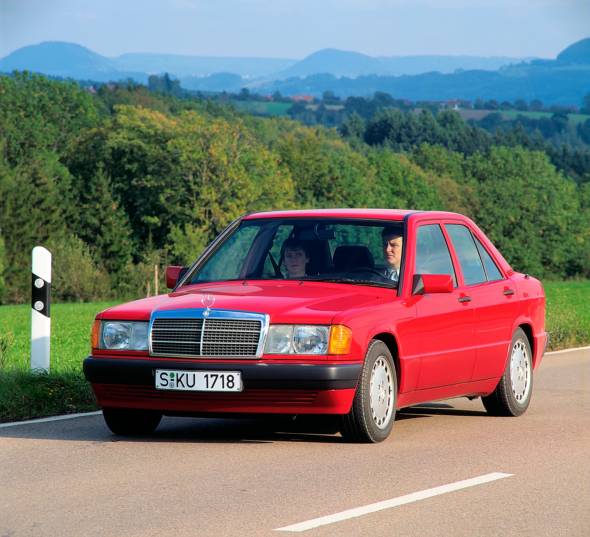
Mercedes-Benz presented another three special models of the W 201 in 1992, the last full year of production of the series. These AVANTGARDE versions of the 190 E 1.8, 190 E 2.3 and 190 D 2.5 were primarily designed to have a more youthful look, including pearl coat finishes in strong colors. In all, 4,600 units were built of these special models.
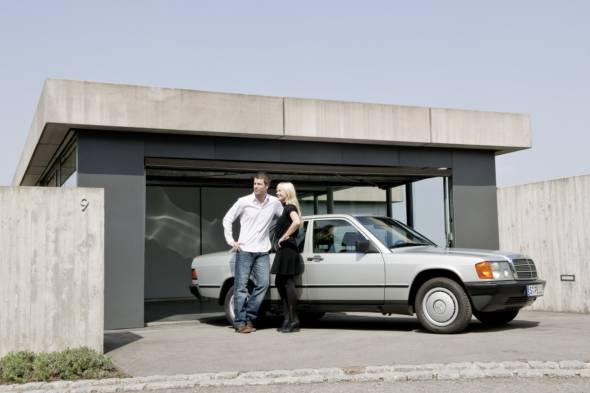
Production of the 190 ended in Sindelfingen in February 1993 and in Bremen in August that same year. A total of 1,879,629 vehicles had been manufactured. This underlines the success of the compact class, and the wisdom of the decision to extend the product range of the Mercedes-Benz brand into lower segments of the market.
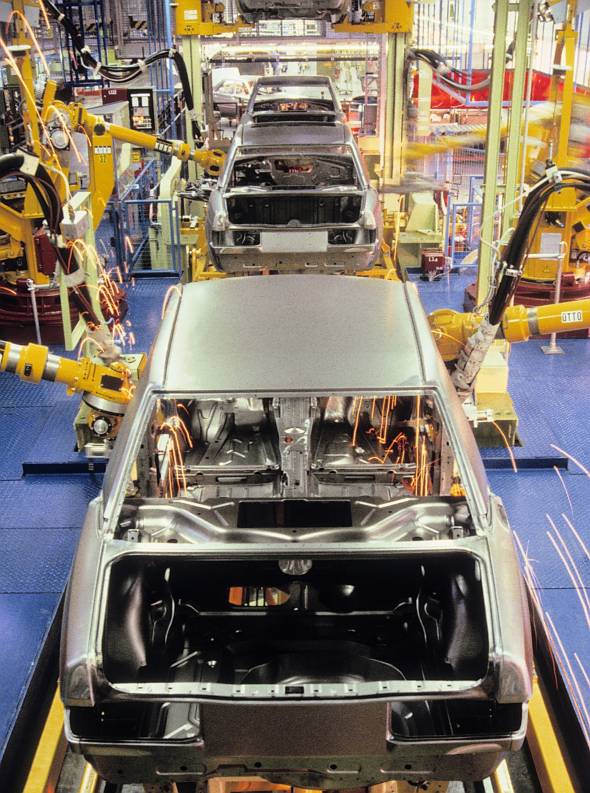
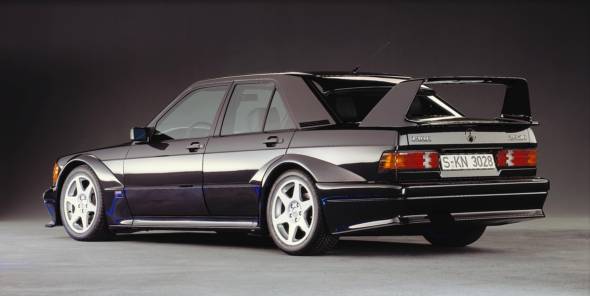
The W 201 series in the press
Frankfurter Allgemeine Sonntagszeitung, November 19, 2006: “The compact class was the first herald of what the future had in store.”
Bruno Sacco, head of Design at Mercedes-Benz from 1975 to 1999, said this about the W 201 in 2000: “The Mercedes 190 was specifically designed to be provocative. We wanted to attract new customers, so we had to get their attention – for example, with a rear-end design that was highly unusual at that time, and with very distinctive contours. When I look at this car today, I still find it very attractive.”
auto, motor und sport, July 14, 1982, on the W 201: “With all its sports performance features, the 190 is still an outstandingly comfortable sedan.”
auto, motor und sport, December 1, 1982, on the new W 201: “The 190 comes with features which have been highly unusual in this class to date: the anti-lock braking system, for example, or the driver airbag and the automatic belt tensioner for the front passenger.”
auto, motor und sport, December 1, 1982, on the multi-link independent rear suspension of the W 201: “This is truly a rear axle unlike anything the world has ever seen.”
auto, motor und sport, December 15, 1982, on the multi-link independent rear suspension of the W 201: “A veritable dream of an axle.”
Auto Zeitung, December 20, 1982, on the debut of the W 201: “Everyone’s talking about the new small Mercedes, the 190/190 E.”
Neue Zürcher Zeitung, December 22, 1982, on the W 201: “A refreshingly and unconventionally styled modern car that can be expected to attract new, and particular young buyers.”
auto, motor und sport, January 12, 1983, on the public reaction to the W 201: “No other car is so much at the center of attention, no other car has generated anything like the curiosity as this new development from the world’s oldest motor manufacturer.”
auto, motor und sport, January 12, 1983, on the design of the W 201: “The W 201 body surrounds the driver like a well tailored suit, proving that you can be comfortable even in a relatively small space.”
auto, motor und sport, March 23, 1983, on the 190 D: “The diesel engine is encapsulated, which means less exterior noise emissions and lower noise levels inside the car.”
Auto Zeitung, October 21, 1983, on the 190 D: “This car continues a diesel tradition going back 47 years, providing ample scope for the development of future generations of compression-ignition engines.”
Road & Track, November 1983, on the 190 2.3: “We think the
Mercedes-Benz 190 E 2.3 is an outstanding four-door sedan – perhaps the best in the world in its size class.”
Road & Track, November 1983, on the design of the W 201: “The styling of the 190 is head-turning.”
Production figures for the Mercedes-Benz W 201 series (1982 – 1993)
| Model | Designation | Production period pre-series – end | Unit numbers |
| 190 | W201 V 20 | 1982 – 1984 | 35,021 |
| 190 E / 190 E 2.0 | W201 E 20 | 1982 – 1993 | 638,180 |
| 190 E 2.3 | W201 E 23 | 1983 – 1993 (before Sept. 1986 export model for North America only) | 186,610 |
| 190 D | W201 D 20 | 1983 – 1993 | 452,806 |
| 190 D 2.2 | W201 D 22 | 1983 – 1985 (export model for North America only) | 10,560 |
| 190 (new engine) | W201 V 20/1 | 1984 – 1991 | 83,540 |
| 190 E 2.3-16 | W201 E 23/2 | 1984 – 1988 | 19,487 |
| 190 D 2.5 | W201 D 25 | 1985 – 1993 | 147,502 |
| 190 E 2.6 | W201 E 26 | 1986 – 1993 | 104,907 |
| 190 D 2.5 Turbo | W201 D 25 A | 1986 – 1993 (before Sept. 1987 export model for North America only) | 20,915 |
| 190 E 2.5-16 | W201 E 25/2 | 1988 – 1993 | 5,743 |
| 190 E 2.5-16 Evolution | W201 E 25/2 | 1989 | 502 |
| 190 E 1.8 | W201 E 18 | 1990 – 1993 | 173,354 |
| 190 E 2.5-16 Evolution II | W201 E 25/2 | 1990 | 502 |
| Total | 1,879,629 |

